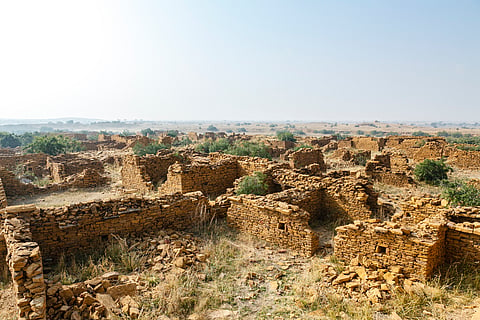
- Destinations
- Experiences
- Stay
- What's new
- Celebrating People
- Responsible Tourism
- CampaignsCampaigns
- SubscribeSubscribe
- Buy Now

India's abandoned towns exude an intriguing charm, inviting travellers to unravel their forgotten narratives. These offbeat destinations provide a rare chance to delve into the past, unearthing untold stories and hidden gems. Here are the top five places in India where history, legends, and myths intertwine seamlessly. Embrace the opportunity to discover the mysteries of these lesser-known sites.
Sidhpur, Gujarat
Sidhpur, a town with solid mythological significance, is believed to be where warrior Parasurama performed the last rites of his mother. The place showcases mansions in pastel shades with notable European architectural influences. Initially, it was inhabited by the Dawoodi Bohra community, who eventually relocated in search of better opportunities. These grand mansions were constructed during their prosperous times and served as regular destinations for the community. Over time, the ties weakened, leading many residents to leave the town. Today, Sidhpur attracts visitors during the annual Sidhpur Camel Festival, which takes place on the banks of the Sabarmati River.
Dhanushkodi, Tamil Nadu
Flanked by the Bay of Bengal and the Indian Ocean, Dhanushkodi is known for its intriguing past. Despite being one of the smallest coastal towns in the world, it retains a sense of eerie quietness. The town suffered severe damage from a massive cyclone in 1964, leading the then-Madras government to declare it unsuitable for habitation. Today, remnants of the past, such as a church and the water tank of the railway station, can still be found amidst the ruins. According to mythological legends, this is the place where Ram is believed to have constructed a bridge, known as the Setu, to connect to Lanka (Sri Lanka).
Unakoti, Tripura
This fascinating site, with numerous rock-cut sculptures and ancient temple ruins, is an ideal destination for archaeology enthusiasts. According to local legends, the place is said to carry Lord Shiva's curse. These sandstone sculptures are scattered throughout the area. Some of the sculptures are still buried beneath the ground and remain unexcavated. The name "Unakoti" is derived from the belief that the sculptures number less than a crore ('koti' in Sanskrit). The origin and creation of these uncut rock statues remain a mystery.
Kuldhara, Rajasthan
Located less than 20 km from Jaisalmer, Kuldhara holds a rich history and intriguing legends. This village was once a prosperous settlement inhabited by Paliwal Brahmins. According to local belief, the village faced adversity when the then-prime minister, Salim Singh, desired to forcefully marry the village head's daughter against her family's wishes. In response, the villagers collectively abandoned their ancestral homes, leaving a curse that prevented future settlement. Today, visitors can witness the remnants of this abandoned village, characterized by rows of mud houses with missing roofs and crumbling walls. The passage of time and the forces of nature have contributed to the captivating, frozen-in-time appearance of the place.
Lakhpat, Gujarat
Kutch, known for its white sand desert, also includes the abandoned town of Lakhpat in its far northwest corner. Once a significant port city, Lakhpat has remained deserted for nearly two centuries following an earthquake in 1819. The earthquake altered the course of the Indus River, leading to the town's abandonment as it gradually dried up. Situated in the northern direction, facing the Great Rann and neighbouring Pakistan, Lakhpat is surrounded by 7 kilometres of fort walls offering serene views. Vast expanses of uninhabited land characterize the area. One of the main attractions of this remote location is the clear night sky, ideal for stargazing due to the unpolluted desert air.
Cover Photo Credit Wikimedia Commons
